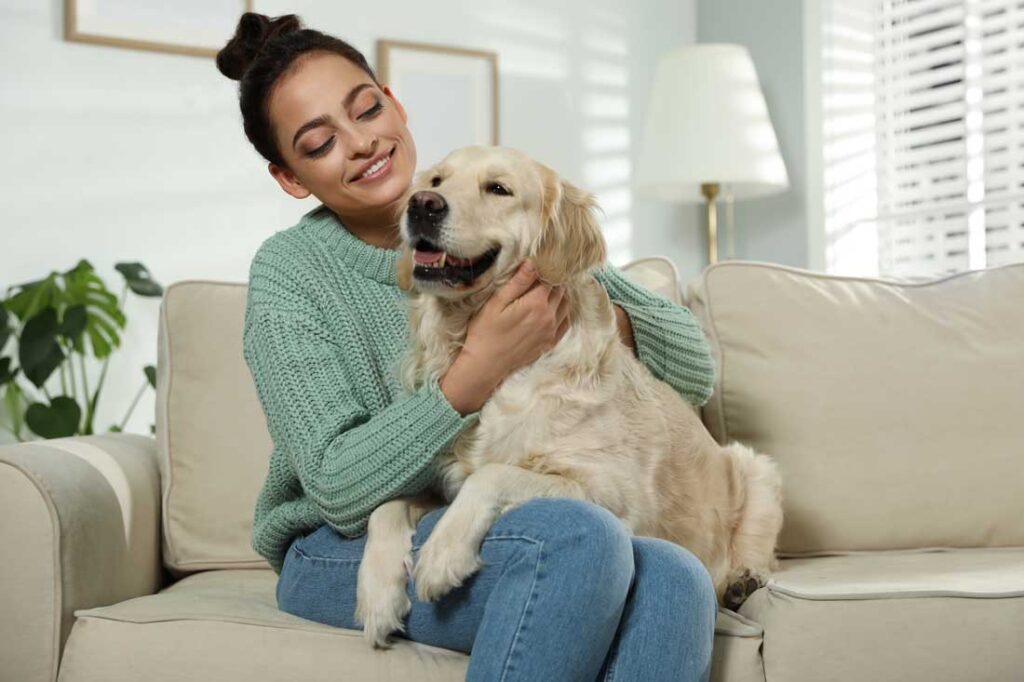For most of my life, I have been a cat person.
I have lived with little house-tigers that sharpened their claws on my couches, played midnight hockey with my hair ornaments and dragged my dirty laundry from the hamper to my pillow. I have even endured the terrifying stare of a cat that sees she’s getting a second night of “seafood surprise” canned food for dinner. But then I married a man who was allergic to cats, and when my last beloved kitty, a dowager queen named Lady Macho, passed on, my husband suggested we get a dog. A dog! What a concept. I figured we’d think about it for a year or three.
And then a friend told us about Jordie, a golden retriever puppy who needed a home. He’d been bred to be a show dog, she said, but when he was 6 months old, a routine X-ray revealed that he had a bit of hip dysplasia—and just like that, his show career was over and he needed a family. We had him for 13 years, five months, three weeks and then part of one day. And in that time, he showed me a lot about life. Whereas my feline companions had taught me about aloofness and how to be cool (qualities I admired but could never master), Jordie taught me the six major life lessons of dog happiness, which work equally well for humans.
1. Live in the moment, a life lesson from my dog.
Whether he was basking in the sun, letting his ears blow in the breeze or rolling in a mud puddle, Jordie was always having a good time. Going for a car ride? A hike in the woods? Taking a nap in the shade? Everything was the best idea ever, and so exciting it was as though it had never happened before. He never felt guilty about it, never thought, Hmmm, I really should be doing my taxes. He just took the joy and thanked whatever the god of dogs brought his way. After watching him awhile, I finally realized that if I didn’t try to interpret, explain and manage everything, if I stopped apologizing for not being productive every minute of my life, I could sometimes almost approach that kind of happiness myself—the happiness of just being.
2. Going a bit insane is wonderful.
I used to pride myself on staying rational, stable and calm. Dogs don’t buy any of that. At least once a day Jordie took off on what we called a “puppy blowout,” wherein he would suddenly sit up at full alert, as if hearing a distant call from his wolf relatives or his home planet. He would then erupt in a full-tilt charge through the house, running in circles through the dining room, kitchen and living room, dashing down the hall and through the bedrooms, leaping up on the beds and down again, then careening up and down the stairs. His ears flew behind him and his eyes were wild—a portrait of pure joy and sheer insanity.
Did he care that he looked ridiculous, that we were definitely laughing at and not with him? Did he fear losing control? Not once. I’ve learned to embrace this dog life lesson and do some puppy blowouts myself, singing at the top of my lungs, dancing like I’m at a disco at closing time or simply getting up from my desk to run and scream for a bit. It’s wonderful.
3. Just showing up is enough.
This is probably one of the great laws of dog happiness and is definitely one of the reasons we love them. Dogs don’t solve our problems and never offer one piece of advice. All they do is sit with us when we’re emotional basket cases, and that’s enough. One day when Jordie and I were out walking, we stopped to talk to a woman we didn’t know.
Usually Jordie, who was shy, stayed close to me, but this time, he went over and stood next to the woman, nudging her hand and then licking it. I apologized for his forwardness. “Oh, that’s OK,” she said, matter-of-factly. “I was just diagnosed with cancer last week, and dogs know how to be with people who are sick.” Sure enough, I started to notice that whenever one of us wasn’t feeling well, Jordie was right there next to our beds, just being present—a St. Bernard without the brandy.
4. Dog life lesson: Feel guilty… and move on.
Dogs are masters of the quick guilt trip. They are so very sorry they ate all the appetizers, unrolled the toilet paper or soiled the floor. For a moment, they are the picture of contrition, lowering their heads and tails, shuffling around, even whimpering about how horrified they are at their scandalous behavior. And then—presto! It’s over! They’re happy again, back to feeling completely unashamed and quite certain you’ve forgiven them. It’s not that dogs don’t know trouble, it’s just that they know something we forgot: Staying in trouble mode is boring, destructive and doesn’t do anybody any good. Go for a puppy blowout or take a nap. Even just wagging your tail might make you feel better.
5. You can’t always be perfect.
I have an ex-husband who wanted our children to mail him a white clam pizza from a certain famous pizza restaurant in our city every year at Christmas. The children didn’t drive, and the pizza place was too snobby to accept phone orders. This meant I had to spend an evening standing in a two-hour line (often in the rain or snow), ordering the pizza, waiting for it to be made, bringing it home, packing it into plastic bags and then into a box and overnight-mailing it to him thousands of miles away, year after year.
Once, after we’d bought the required pizza but before we could pack it up, Jordie came running into my bedroom with that “Timmy in a well” look that all watchers of Lassie remember. We followed him to the living room, where it turned out there were slices of pizza strewn everywhere. Some had dog-sized teeth marks in them. Others were simply missing altogether. Jordie dashed around in circles, seemingly distraught at what he had done, before he forgave himself and went to lie down and digest his pizza dinner.
It didn’t take me long to figure out what to do. I threw away the obviously “used” slices and dusted off the ones that were resting on the couch and on the rug. And then, yes, I packed them up in plastic bags and sent them off the next morning in the mail. Oddly enough, I didn’t even feel bad about it. Or if I did, then much like Jordie, I got over it quickly. And there was a bonus: I was never asked for another clam pizza.
6. Dog life lesson: Learn to let go.
Make no mistake: Dogs love their possessions just the way humans do. Jordie often had a special stuffed animal friend, a treasure he guarded and protected like his own dear child. When he was in the throes of these relationships, he wouldn’t even go for walks without his “lovey” coming along. And then, months later, for no reason I could discern, the relationship would simply be over. He would awaken one day, take a look at his beloved and heave a sigh that spoke volumes: Regret was there, and sadness, but also a kind of acceptance of a difficult fact. It was time to say goodbye.
Perhaps this was a mutual parting of the ways that they both acknowledged at some dog-to-polyester level. He would carry the stuffed animal outside and place it behind our shed, never to be visited again. And that was it. When he came back into the house, he was done, free from his responsibilities. It clearly hadn’t been easy, but it was over. If it’s not easy to say goodbye to a stuffed animal, it must be even harder to say goodbye to life. But that day came, too.
At the end, he had a series of strokes that at first made it difficult for him to walk straight and then made it impossible for him to walk at all. We couldn’t bear to give him up, yet we knew we had to. But how do you decide when? We spoke of almost nothing else for weeks. The vet said that when Jordie was no longer taking pleasure from life, that might be the time to have him put down.
Finally I made the appointment, the last one of the evening. Jordie and I spent the afternoon together, and I sat with him while he dozed on the floor. I offered him all the forbidden treats he loved: chocolate candies and bites of ice cream. He obligingly took a few nibbles, but I sensed he was only doing this for me.
The truth was that he was ready. He put his head next to my hand, the way he’d done with the lady who had cancer. Then he sighed, the way he had when he was about to say goodbye to a stuffed animal. I knew it was me he was comforting, not himself. He was ready to slip away, to ride that moment right out of there—without fear, without panic, without regret. I recognized the same wordless happiness he’d always known. He licked my hand, took one more deep breath, and then he was quiet. We sat together until it was time to go.
This article was updated April 2023. Photo by New Africa/Shutterstock





